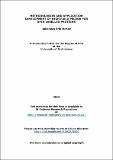Files in this item
Methodologies and application development of high field PELDOR for spin labelled proteins
Item metadata
| dc.contributor.advisor | Smith, Graham Murray | |
| dc.contributor.author | McKay, Johannes Erik | |
| dc.coverage.spatial | xi, 215 p. | en_US |
| dc.date.accessioned | 2016-05-18T12:03:55Z | |
| dc.date.available | 2016-05-18T12:03:55Z | |
| dc.date.issued | 2016-06-22 | |
| dc.identifier | uk.bl.ethos.687023 | |
| dc.identifier.uri | https://hdl.handle.net/10023/8820 | |
| dc.description.abstract | The function of a biological molecule is linked to its underlying structure, and determination of that structure can lead to significant insights into its function and how this is performed. There already exist a number of important tools in structural biology, however, the pulsed electron paramagnetic resonance (EPR) technique called pulsed electron-electron double resonance (PELDOR) is the only one capable of accurately measuring isolated distances between attached spin-labels over the range of ~2 to 10 nm, a range which is usually impossible to measure directly with other techniques such as nuclear magnetic resonance (NMR) and X-ray crystallography. This can provide constraints for refinement of structures determined from NMR and X-ray crystallography, or insights into protein docking and protein mechanics. With recent developments in EPR spectrometer instrumentation and spin-labelling it has become possible to conduct PELDOR experiments in the high field EPR regime (>3 Tesla) where measurement sensitivity is increased. These experiments can reveal relative orientations of nitroxide spin-labels in complement to their separation, however, analysis and interpretation of these results has been difficult to perform routinely. This thesis presents a characterisation of the high field spectrometer HiPER showing that it is well suited when optimised for making PELDOR experiments. To perform analysis of PELDOR signals from this spectrometer custom signal simulation code has been written. Two case studies are presented. The first relates to the use of the Rx spin label with the PELDOR experiment to derive orientation information from the spin labelled protein Vps75. The recently developed spin label Rx is proposed to attach more rigidly to underlying structure, offering potentially increased accuracy in determination of structure constraints and additional information about relative orientations of different structural features. An orientation selective PELDOR study is presented which compares molecular dynamics (MD) simulations of spin labels attached to sites on the α-helix of the protein Vps75. This has shown great potential for utilising the Rx spin label in a repeatable way on α-helix residue sites for determination of structural constraints. The second case relates to orientation selective PELDOR measurements of spin labelled oligomeric membrane protein structures. High field PELDOR offers great potential in increasing measurement sensitivity and accuracy of structural constraints in oligomeric proteins. A methodology of signal analysis for this class of protein is presented along with measurements of the membrane channel protein MscS. Difficulties of PELDOR measurement on these labelled proteins are discussed and observed relaxation of the spin echo, relevant to pulsed EPR experiments, are investigated and possible mechanisms are presented. | en_US |
| dc.language.iso | en | en_US |
| dc.publisher | University of St Andrews | |
| dc.subject | EPR | en_US |
| dc.subject | Magnetic resonance | en_US |
| dc.subject | PELDOR | en_US |
| dc.subject.lcc | QC763.M6 | |
| dc.subject.lcsh | Electron paramagnetic resonance | en_US |
| dc.subject.lcsh | Spin labels | en_US |
| dc.subject.lcsh | Proteins--Structure | en_US |
| dc.title | Methodologies and application development of high field PELDOR for spin labelled proteins | en_US |
| dc.type | Thesis | en_US |
| dc.contributor.sponsor | Engineering and Physical Sciences Research Council (EPSRC) | en_US |
| dc.type.qualificationlevel | Doctoral | en_US |
| dc.type.qualificationname | PhD Doctor of Philosophy | en_US |
| dc.publisher.institution | The University of St Andrews | en_US |
This item appears in the following Collection(s)
Items in the St Andrews Research Repository are protected by copyright, with all rights reserved, unless otherwise indicated.

